Coupling Path of China's Modern Service Industry and Agriculture Based on Improved Entropy Method
Shouwu JING,Yong XIA,Honghong CHEN
School of Economics and Business,Xinjiang Agricultural University,Urumqi830052,China
1 Introduction
In 2012,the proportion of three industries was10.1∶45.3∶44.6 in China;compared to 2000,the proportion of primary industry fell by 5 percentage points,while the proportion of tertiary industry rose by 5.6 percentage points,indicating that the industrial structure was further optimized.In Transforming Traditional Agriculture,Theodore W.Schultzbelieves that the key to the transformation of traditional agriculture is introducing the modern factors of agricultural production that reduce the prices of agricultural income streams[1].The modern service industry is the internal mechanism of optimization and upgrading of industrial structure[2],and domestic and foreign academic circles have conducted in-depth research on the relationship between modern service industry and agriculture.In terms of foreign research,John,Eric and Schacht explore the negative impact of agricultural insurance on agricultural production from the agricultural moral hazard,and propose the policies for reducing the unfavorable impact of moral hazard on agricultural insurance company[3].So of considers that the development of the logistics industry has a profound impact on the supply of agricultural products and quality of agricultural products and the level of agricultural logistics is essential to the assurance of the quality of agricultural products[4].Bennet believes that the market is the key to the transformation of agricultural scientific and technological achievements and improvement of agricultural technology efficiency and agricultural productivity[5].From the combination of traditional leisure and agriculture,Sharon Phillip comes up with the new tourism and leisure agriculture and sum sup five types of integration of tourism and agriculture[6].Murphy and Oppermann analyze the reasons for tourists'agri-tourism behavior from environmental and economic motivations,respectively.Domestic studies on the correlation between modern service industry and agriculture started relatively late.Pan Jinyun,Wang Shizhen and Li Yanshu(2011)select six indicators in modern service industry to test the influence on agriculture,and find that the total power of agricultural machinery plays the most evident role in transformation of agriculture while the role of other indicators is not obvious[7].Hu Yiqin and Wang Hongyuan(2014)conduct study and find that Zhejiang's modern service industry and agriculture are at the stage of moderate coupling,and the coupling field is not wide enough[8].By the VAR model and variance decomposition,Pan Zheng and Wang Xiaofei(2011)find that there is a relationship of mutual promotion between Guangdong's agriculture and productive service industry,but agriculture weakly explains productive service industry.By analyzing the problems concerning innovation,human resources and policy support in agriculture and modern service industry,HeWeizhong(2014)concludes that it is necessary to improve the level of agricultural services by enhancing the modern service industry system[10].By analyzing the current situation and problems about the development of agriculture and modern service industry in Zhejiang,Wang Hongyuan derives three development patterns for modern agricultural service industry in Zhejiang[11].On the basis of the1993-2010 time series,Yuan Zhongxu(2013)builds a C-D function model and conducts an empirical analysis to conclude that the coupling of tourism and agriculture is the driving force of rural industrial development,and it can be the dominant mode of rural tourism development[12].Liu Jia and Zhang Rongting(2012)use AHP method to arrive at a conclusion that four agricultural science and technology information service modes can be vigorously promoted in China[13].In fact,the relationship between modern service industry and agriculture is coupled and coordinated through the interaction and mutual restraint between different level factors.Based on the existing research results,this paper selects various indicators,uses the improved entropy method to determine the weight,and employs coupling degree and coordination degree to study the coupling effect of modern service industry and agriculture.By the empirical analysis,this paper determines the coupling path of modern service industry and agriculture,in order to provide a reference for promoting the industrial integration between modern service industry and agriculture.
2 Coupling mechanism of modern service industry and agriculture
The industrial coupling is the positive association between various industries based on system theory[14],and the basis for the emergence and development of modern agricultural service industry[8].The dissipative structure model can be used to analyze the coupling between the development of modern service industry and agricultural structure.Prigogine et al.believe that the dissipative structure is the stable and orderly organizational structure in a nonequilibrium state,and modern service industry system and agricultural system are open and far from equilibrium.The various elements within the system have non-linear effects,and they are mutually restricted and promoted.In the open system,the material,energy,information and other"mutation"factors lead to an orderly fluctuation within the system,so as to achieve rebalancing between modern service industry and agricultural system(Fig.1).In the system,the greater the entropy,the less the amount of information carried,and the more chaotic the system;the smaller the entropy,the more the information contained in the system,and the more orderly the system.The change in the entropy of modern service industry and agriculture is divided into two parts:one is the increase in entropy by themselves(dis,dis≥0),and the other part is the entropy flow caused by the energy and material exchange with the outside world(des≥0 or des≤0).The entropy change of the whole system is ds=dis+des.When des is greater than zero,ds is also greater than zero,and the two systems are in the disordered state.With the increase of external negative entropy flow,ds is gradually less than zero,and the system will gradually become disorderly to orderly.After the formation of orderliness,dis=-︱des︱,ds=0,and the system is in an orderly state of low entropy,namely forming dissipative structure.The modern service industry and agriculture system change from"competition"stage to"cooperation"phase.The development of modern service industry affects the upgrading of agriculture through three paths.(i)The lock-in effect of the development of modern service industry.The lock-in effect was raised by Arthur in 1989[15].Now the lock-in effect has widespread effects on the entire resource configuration[16].Chen Feixiang notes that with the improvement of the level of modern service industry,the profit level of modern service industry and labor productivity is higher than that of agriculture,and in the market economy,"resources"have profit-driven nature,thereby leading to"resource lock-in","technology lock-in"and"policy lock-in"effects of modern service industry on agriculture.(ii)Cause effect and threshold effect.Hirschman considers that in terms of scale and technology change,one industry will be linearly correlated with other industries[17].The progress of modern service industry and especially technology has cause effect on the upgrading of agriculture,but such cause effect is affected by many factors.If the R&D level of agriculture is not high,the modern service industry will not have a positive effect on agriculture,but produce a threshold effect.The positive effect of modern service industry on upgrading of agriculture depends on the joint action of positive"cause effect"and negative"threshold effect".(iii)Diamond effect.Diamond theory believes that the business competition between various industries can help to achieve the upgrading of industrial structure and realize the industrial integration through industrial linkage.With enterprise as a bridge,the competition between industries can achieve vertical and horizontal linkage between modern service industry and agriculture,and industrial integration.Therefore,the effect of modern service industry on agriculture depends on the total effects of four paths("lock-in effect","cause effect","threshold effect"and"diamond effect")on agriculture.The integration effects of modern service industry and agriculture still need to go through empirical testing.
3 The indicator system for the coupling effect of modern service industry and agriculture
3.1 Building of the indicator systemOn the basis of existing studies,according to the principles of completeness,scientificity,operability and comparability,combined with the actual sit-uation of China's modern service industry and agricultural development,we choose the average of evaluation indicators as far as possible to build the evaluation indicator system for the degree of coordination between modern service industry and agriculture(Table 1),including 5 indicators(development scale,development efficiency,development potential,economic vitality and technological development base capacity),a total of14 individual indicators.
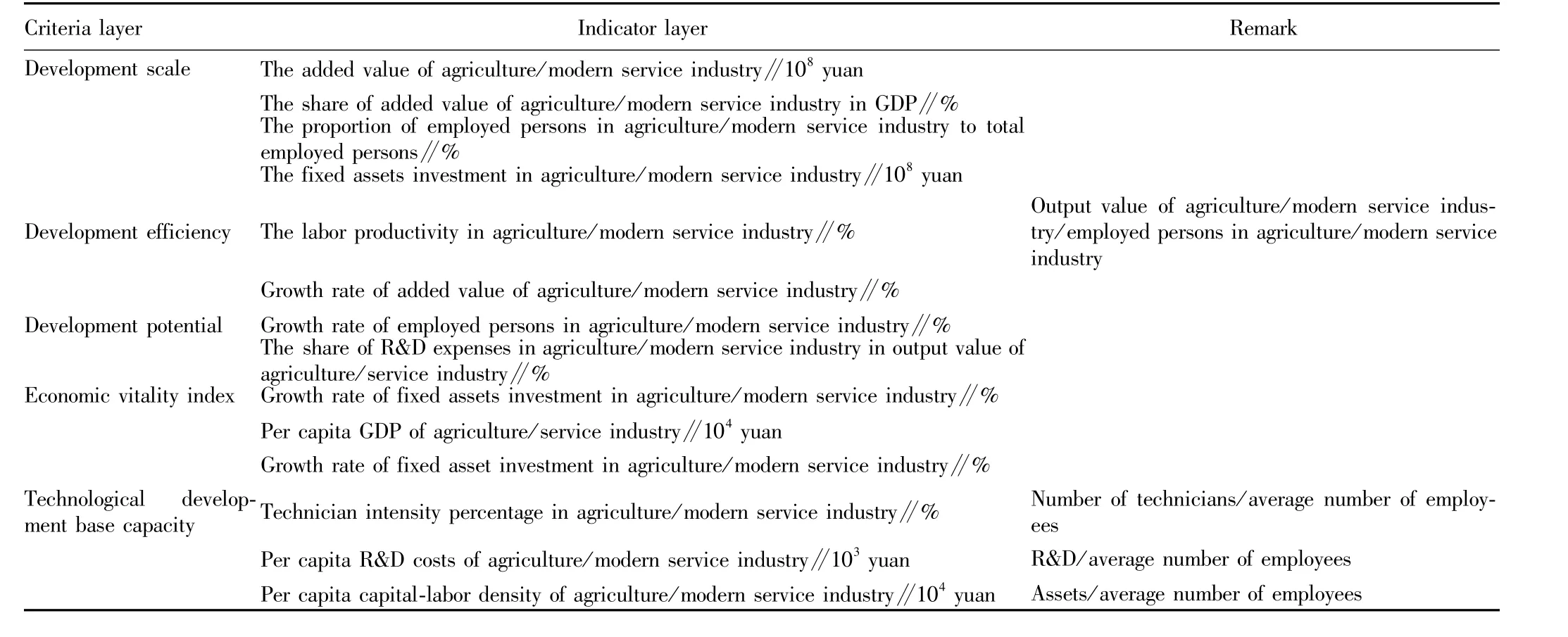
Table 1 The indicator system for the coupling of modern service industry and agriculture
3.2 Descriptive statistics of indicatorsThis paper selects the data during 2000-2012 to study the coupling effect of modern service industry and agriculture in 13 years.The indicator data are from China Statistical Yearbook and Statistical Yearbook of Chinese Science and Technology during 2000-2012.The descriptive statistics of indicators are shown in Table 2 and 3.As can be seen from the table,the added value of modern service industry,added value of agriculture,fixed assets investment in modern service industry,fixed assets investment in agriculture,per capita GDP of modern service industry and per capita GDP of agriculture are large values,while the original values of other variables are mostly smaller.
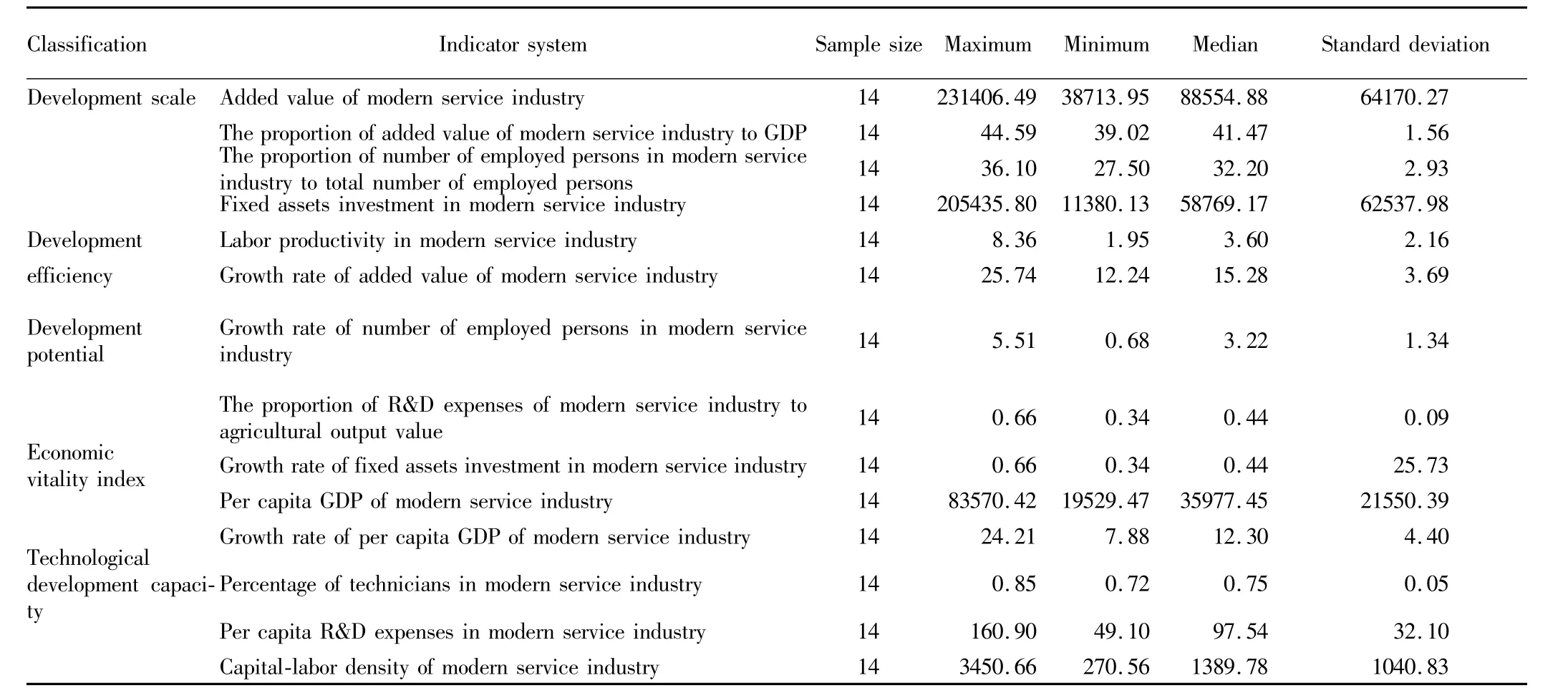
Table 2 Descriptive statistics of indicator variables of modern service industry
3.3 Data normalization and weight
(i)In this paper,we use the entropy method to establish the objective weight of evaluation system for service industry and agriculture.By calculating the information entropy of the indicators determined,the entropy method is used to determine the weight of indicators according to the overall impact of relative change degree of indicators on system(utility value).The higher the relative change degree of indicators,the greater the weight of indicators,and vice versa.

Table 3 Descriptive statistics of indicator variables of agriculture
(ii)To eliminate the impact of inconsistency between dimension and magnitude on the result,there is a need to make data dimensionless,and this paper chooses the min-max normalization.The indicators are divided into positive and negative indicators.It is calculated as follows:
Positive indicators:
(iii)In order to eliminate the impact of negative and zero values,we make the coordinate x′ijmove along and it changes into x″ijafter the parallel movement of H units,namely x″ij=x′ij+H,where H is the movement magnitude of the coordinate[18].
(iv)The proportion of indicator j in year i is calculated as follows:
(v)The entropy value of indicator j(e)is calculated as follows:
(vi)We calculate the coefficient of variation of indicator j.For indicator j,the greater the difference between the indicator values,the smaller the entropy.The coefficient of variation is calculated as follows:
(vii)We use the entropy method to calculate the indicator weight,as shown in formula(6).
The weight of indicators is shown in Table 4 and 5.

Table 4 The indicator weight in criteria layer and indicator layer for modern service industry

Table 5 The indicator weight in criteria layer and indicator layer for agriculture
4 The coupling evaluation model for modern service industry and agriculture
4.1 Coupling degree modelLet C be coupling association degree of multiple systems,and we build the coupling degree model based on the capacity coupling model in physics.The coupling degree model of multiple systems is as follows:
where u1and u2are comprehensive contribution degree,and the comprehensive contribution degree of modern service industry and agriculture is shown in Table 6,7;C is the coupling degree,0≤C<1,C never reaches1.The coupling degree and coupling stage criteria are shown in Table 8.

Table 6 The contribution value of indicator layer of modern service industry

Table 7 The contribution value of indicator layer of agriculture
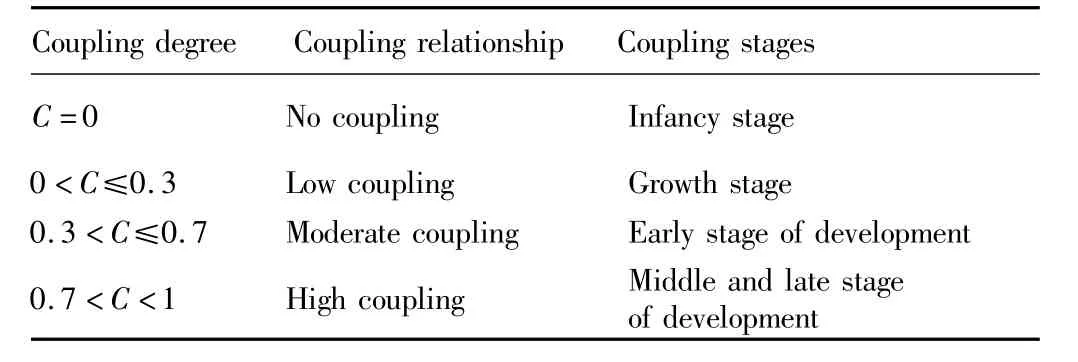
Table 8 The coupling degree and coupling stages
4.2 Coup ling coordination degree modelThe coupling degree model has some limitations in reflecting the coupling relationship between modern service industry and agriculture,that is,the coupling degree may be high while the modern service industry and agriculture are at a low level,so it can not truly reflect the development state of modern service industry and agriculture.In order to more accurately reflect the overall development level of the two industries,there is a need to further build the coupling coordination degree model for analysis(Table 9).The coupling coordination degree model is D=(C+T)1/2,where C is the coupling degree of modern service industry and agriculture,and T is the coordination index between modern service industry and agriculture.T=αf+βg,α+β=1,whereαandβ represent the contribution coefficients of modern service industry and agriculture,respectively(α=0.6,β=0.4 in this paper).

Table 9 Coupling coordination degree and development types
4.3 Results and analysis
4.3.1 Calculation results of coupling degree and coupling coor-dination degree.The calculation results of coupling degree and coupling coordination degree can be shown in Table 10.

Table 10 The coupling degree and coupling coordination degree of modern service industry and agriculture and evaluation results
4.3.2 Coupling model analysis of China's modern service industry and agriculture.As can be seen from Fig.2,the coupling degree of China's modern service industry and agriculture always hovered in 0.4-0.5,and was in a steady state,while the coupling coordination degree of China's modern service industry and agriculture showed a fluctuated upward trend,rising from the initial 0.2658 to 0.5775 in 2012,and the coupling coordination degree was gradually improved.First of all,the coupling degree of China's modern service industry and agriculture was 0.3-0.7,indicating that there is moderate coupling between China's modern service industry and agriculture,and it is at the early stage of development.From a practical point of view,China's service industry and agriculture have already had a large scale after three decades of reform and opening up,and modern service industry has played an active role in promoting the upgrading of industrial structure of agriculture.However,due to low coupling degree of China's modern service industry and agriculture,it has not yet formed coupled integrated competitiveness,so the coupled effect of economies of scale is not obvious.The coupling coordination degree of modern service industry and agriculture is in the process of gradual improvement,rising from moderate and mild declining to the brink of declining to transitional declining,indicating that the coupling basis of China's modern service industry and agriculture is gradually increased,showing coupling positive correlation,but the two systems were at the transitional stage in 2012,indicating that the correlation between China's modern service industry and agriculture is not strong,the coupling mechanism is not perfect,and the coupling industry chain and coupling scale construction is relatively slow.
5 Empirical analysis of the coup ling effect of China's modern service industry and agriculture
In accordance with the evaluation model for coupling coordination degree,China's service industry and agriculture are at the transitional coupling level.Service industry as a factor of production to go into agriculture can promote the further subdivision of agricultural labor,thereby enhancing the industrialization and marketization of agriculture as a whole,improving the market competitive-ness of agricultural products and increasing farmers' income[19].The development of service industry plays a role in promoting the industrialization and marketization of agriculture,because the industrial correlation between China's modern service industry and agriculture is gradually increased.This paper selects the statistics during 1990-2012 to further measure the spillover effects of China's modern service industry on agriculture.
5.1 The theoretical model for spillover effects Based on Feder's two-sector model,the model formula is as follows:
where Y represents the integrated yield of agriculture and modern service industry;A represents the yield of agriculture;S represents the yield of modern service industry;K and L represent the capital and labor input,respectively,and AK/SK=AL/SL=1+γ(γtakes any value).
H1:The modern service industry affects the development of agriculture with a constant coefficient of elasticity(Lai Mingyong,Yang Xiaoxiao,2002),namely A=G(Ka,La,S)=SρΨ(Ka,La);
By taking the derivative of Y,we get formula as follows:

5.2 Description of data and indicatorsY represents the integrated yield of agriculture and modern service industry;A represents the yield of agriculture;S represents the yield of modern service industry;K and L represent the capital and labor input,respectively.Investment I uses the perpetual inventory method,and Kt=Kt-1+I-εKt-1,whereε=0.06.The labor forces are the employed persons in China's agriculture and modern service industry,and all data are from China Statistical Yearbook.In order to unify the dimensions and magnitude of different data,we take 1990 as the base period for deflation.
5.3 Analysis process and results of econometric model
5.3.1 Stationarity and cointegration.The time series(1990-2012)has the feature of autocorrelation,so that the time series is not stationary,and OLS faces spurious regression.In this paper,ADF unit root test uses the testing type with constant term but without time trend to test dY/Y,I/Y,dI/I,dS/S,dS/S*S/Y,and the results are shown in Table 11.According to the unit root test results,the first-order differential of dY/Y,I/Y,dI/I,dS/S,dS/S*S/Y rejects the null hypothesis at the 1%confidence level.Therefore,dY/Y,I/Y,d I/I,dS/S,dS/S*S/Y are I(1),and we can make further cointegration.In order to study whether there is a long-term stable relationship between China's modern service industry and agriculture,there is a need to conduct cointegration test on d Y/Y,I/Y,dI/I,dS/S,dS/S*S/Y.We perform the least squares regression on LY and LX to get the residual u,and conduct the unit root test on the residual.The test result is that u shows first-order stability at the 1%level,so dY/Y,I/Y,dI/I,dS/S,dS/S*S/Y are cointegrated variables.
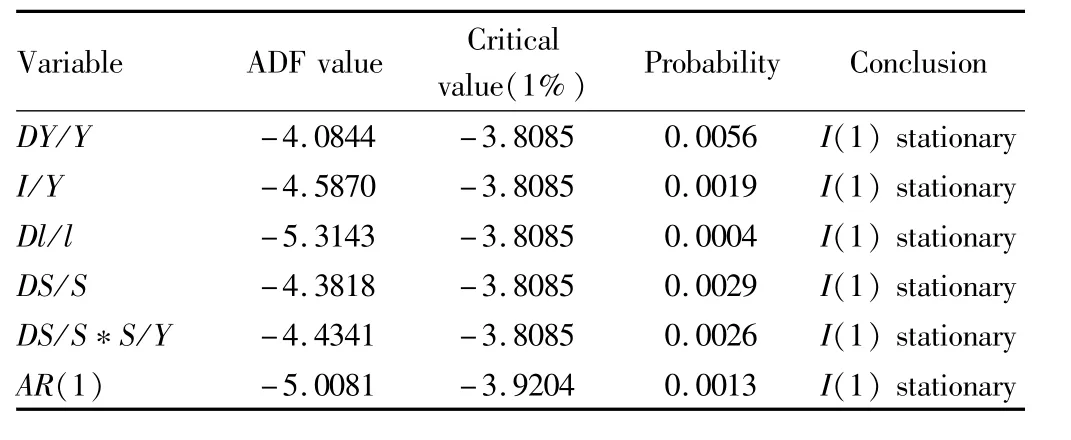
Table 11 Unit root test results
5.3.2 Autocorrelation test.By testing,it is found that the correlation coefficient and partial correlation coefficient of the original equation have first-order autocorrelation and the autocorrelation coefficientρ=0.234,so generalized least squares(GLS)is used.The parameter results of estimation model can be shown in Table 12.The correlation coefficient of model is 0.9448,the adjusted correlation coefficient is0.9264,and F statistic is53.3408(P=0.0000),indicating that this economic model significantly holds.t-statistic of dS/S is 4.4476(P=0.0005),indicating that this coefficient holds at the 1%significance level.The coefficient of dS/S is 0.8990,passing the significance test.China's modern service industry has significant spillover effects on China's economic development and agricultural progress.Take the average of S/Y during 1990-2012,spillover effects:p(l-S/Y)=0.4992×(1-43%)=0.2845.
5.4 The empirical results of spillover effectsDuring1990-2012,for each additional one percentage point of China's modern service industry,agricultural economy can grow by 0.2845 percentage points.The coupling development of China's modern service industry and agriculture shows that China's service industry has become an important factor of production for agricultural development,and the service industry can increase capital,labor and other factor inputs to agriculture,enhance the conversion rate of science and technology,absorb surplus labor and ultimately promote agricultural development through spillover effects.
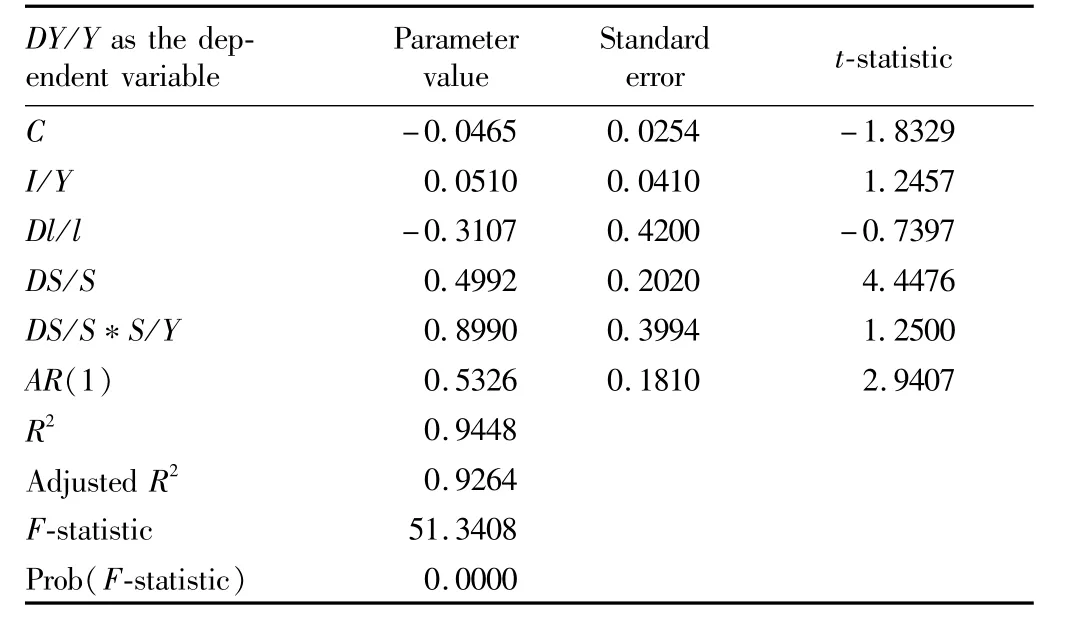
Table 12 Estimation results ofmodel parameters
6 Recommendations
6.1 Promoting the integration of tourism and agriculture
It is necessary to make China's tourism industry nurture agriculture,use science and technology to protect the environment in the process of coupling between tourism and agriculture,continue to develop"agritainment"and explore diversified agricultural tourism,learn from the new coupling model of agriculture and tourism such as"Creative Flower"in Chengdu,and enrich the content of agricultural tourism with the active guidance of the government.
6.2 Promoting the integration of rural finance and agricultureIt is necessary to reduce the threshold of rural financial development,decrease the threshold effect of rural finance on agricultural development,ensure the agglomeration level of rural banking sector,vigorously develop rural insurance and securities,expand the financial scale in the countryside,improve the service functions and market positioning of rural banks and insurance and securities institutions,and improve the service efficiency and development level of rural finance to achieve positive interaction between rural finance and agriculture.
6.3 Promoting the integration of science and technology,information and agricultureIt is necessary to use information and technology to promote science and technology,strengthen the construction of China's agricultural science and technology information sharing,improve science and technology information service system,innovate upon technology information service model,combine the research of scientific institutes with farmers and agricultural education,strengthen the construction of agricultural education and science and technology system,and improve farmers' scientific and cultural quality and technological innovation literacy[21].
6.4 Promoting the integration of logistics industry and agricultureIt is necessary to improve agricultural market system,strengthen the construction of agricultural product logistics infrastructure,improve logistics technology to develop cold chain logistics,use collaborative development model to develop third party agricultural logistics,and build the Internet-based modern agricultural logistics system.
[1]SCHULTZ TW.Transforming traditional agriculture[M].LIANG XM(Translator).Beijing:The Commercial Press,1987.(in Chinese).
[2]LIJM,CUIYC.Research on the optimizing mechanism of modem service industry to industrial structure[J].Industrial Technology&Economy,2013(9):10-16.(in Chinese).
[3]Horwitz J,Erik Lichtenberg.Insurance moral hazard and chemical use in agriculture[J].American Journal of Agricultural Economy,1993(11):926-935.
[4]Sloof M,Tijsens Lmm,Wilkinson EC.Concepts for modeling quality of perishable product[J].Trends in Food Science and Technology,1986(7):165-170.
[5]Wooldridge,Jeffery M.Econometric analysis of cross section and panel data[M].Mitpress,2002:117.
[6]Sharon Phillip,Colin Hunter,Kirsty Blackstock.A typology for defining agritourism[J].Tourism Management,2010(31):754-758.
[7]PAN JY,WANG SZ,LIYS.Research on the theory of modern service industry transforming traditional agriculture[J].Economist,2011(12):40-47.(in Chinese).
[8]HU YQ,WANG HY.The path choice of coupling development of modern service industry and agriculture—Taking the case of Zhejiang Province[J].Journal of Agrotechnical Economics,2014(4):25-33.(in Chinese).
[9]PAN Z,WANG XF.Empirical study on the interaction between agriculture and producer service industry--Take Guangdong as example[J].Guangdong Agricultural Sciences,2011,38(19):164-166.(in Chinese).
[10]HEWZ.Study on the countermeasures accelerating the development of modern agriculture service industry[J].Rural Economy and Science-Technology,2014,25(3):30-31.(in Chinese).
[11]WANGHY.Exploration and analysis on modern agriculture service mode and path in Zhejiang Province[J].Guide to Business,2013(19):118-119.(in Chinese).
[12]YUAN ZX.Dynamic effects and development tendency of coupling between rural tourism industry and big agriculture[J].Tourism Tribune,2013(5):80-88.(in Chinese).
[13]LIU J,ZHANGRT,ZHANGXL,etal.A comparative study on main agricultural sci-tech information service model in China[J].Journal of Agrotechnical Economics,2012(6):63-72.(in Chinese).
[14]LISC.Study on the theory and model of the coupling development of strategic emerging industry and traditional industries[D].Hunan:Central South University,2010:12-16.(in Chinese).
[15]ARTHURWB.Competing technologies,increasing returns and lock-in by historical events[J].The Economic Journal,1989(394):116-131.
[16]CHEN XF,YU ZY,JU L.Lock-in effect and industrial structure evolution in China:1992—2006[J].Economist,2010(5):54-61.(in Chinese).
[17]MCLAREN J.Globalization and vertical structure[J].American Economic Review,2000(90):1239-1254.
[18]TAO XY,ZHANGRJ,XUH,et al.Assessment of city’s sustainable development based on improved entropy method[J].Journal of Arid Land Resources and Environment,2006,20(5):38-41.(in Chinese).
[19]LIQP.Analysis on the correlation between producer services and agriculture in China[J].Seeker,2008(4):64-65.(in Chinese).
[20]XIAO JZ.Study on the integrative development between modern agriculture and service industry—Based on the practical analysis of Zhejiang[D].Hubei:Huazhong Agricultural University,2012:39-41.(in Chinese).
[21]KAN ZH.Study on the influencing factors of the development of modern agriculture service industry in Huai’an City[J].Hunan Agricultural Sciences,2012(10):34-37.(in Chinese).
 Asian Agricultural Research2015年12期
Asian Agricultural Research2015年12期
- Asian Agricultural Research的其它文章
- Bayesian Analysis of Small Multi-frequency Investment of Agricultural Products
- Effort Levels of Capital-constrained Retailer under Bank Financing
- Frontier and Evolution of Marketing Discip line Based on Scientific Metrological Analysis of Top 4 Marketing Periodicals in 2009-2013
- Changes in Net Barter Term s of Trade for Sino-Australian Agricultural Products after China's Accession to the WTO
- Systematic Analysis and Innovation for Development Policies of Beijing Seed Industry at Transformation Stage
- Effect of Agricultural Comprehensive Development on Increasing Income of Farmers in Jiangsu Hilly and Mountainous Areas
